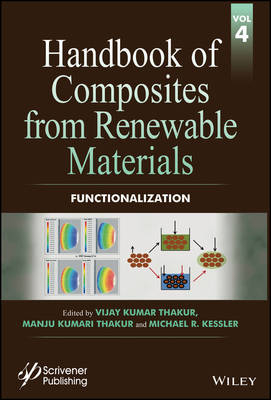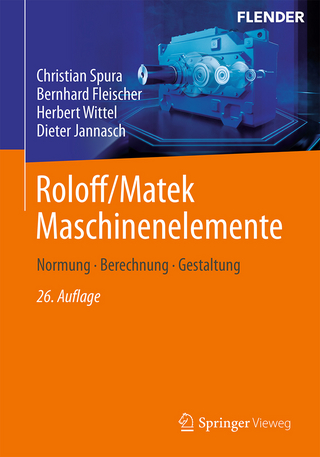
Handbook of Composites from Renewable Materials, Functionalization
Wiley-Scrivener (Verlag)
978-1-119-22367-2 (ISBN)
The Handbook of Composites from Renewable Materials comprises a set of 8 individual volumes that brings an interdisciplinary perspective to accomplish a more detailed understanding of the interplay between the synthesis, structure, characterization, processing, applications and performance of these advanced materials. The Handbook comprises 169 chapters from world renowned experts covering a multitude of natural polymers/ reinforcement/ fillers and biodegradable materials.
Volume 4 is solely focused on the Functionalization of renewable materials. Some of the important topics include but not limited to: Chitosan-based bio sorbents; oil spill clean-up by textiles; pyridine and bipyridine end-functionalized polylactide; functional separation membranes from chitin and chitosan derivatives; acrylated epoxidized flaxseed oil bio-resin and its biocomposites; encapsulation of inorganic renewable nanofiller; chitosan coating on textile fibers for functional properties; surface functionalization of cellulose whiskers for nonpolar composites; impact of chemical treatment and the manufacturing process on mechanical, thermal and rheological properties of natural fibers based composites; bio-polymers modification; review on fibers from natural resources; strategies to improve the functionality of starch based films; the effect of gamma-radiation on biodegradability of natural fibers; surface functionalization through vapor-phase assisted surface polymerization (VASP) on natural materials from agricultural by-products; okra bast fiber as potential reinforcement element of biocomposites; silane coupling agent used in natural fiber/plastic composites; composites of olefin polymer /natural fibers: the surface modifications on natural fibers; surface functionalization of biomaterials; thermal and mechanical behaviors of bio-renewable fibres based polymer composites; natural and artificial diversification of starch; role of radiation and surface modification on bio-fiber for reinforced polymer composites.
Vijay Kumar Thakur is a Lecturer in the School of Aerospace, Transport and Manufacturing Engineering, Cranfield University, UK. Previously he had been a Staff Scientist in the School of Mechanical and Materials Engineering at Washington State University, USA. He spent his postdoctoral study in Materials Science & Engineering at Iowa State University, USA, and gained his PhD in Polymer Chemistry (2009) at the National Institute of Technology, India. He has published more than 90 SCI journal research articles in the field of polymers/materials science and holds one US patent. He has also published about 25 books and 33 book chapters on the advanced state-of-the-art of polymers/materials science with numerous publishers, including Wiley-Scrivener. Manju Kumar Thakur has been working as an Assistant Professor of Chemistry at the Division of Chemistry, Govt. Degree College Sarkaghat Himachal Pradesh University, Shimla, India since 2010. She received her PhD in Polymer Chemistry from the Chemistry Department at Himachal Pradesh University. She has deep experience in the field of organic chemistry, biopolymers, composites/ nanocomposites, hydrogels, applications of hydrogels in the removal of toxic heavy metal ions, drug delivery etc. She has published more than 30 research papers in peer-reviewed journals, 25 book chapters and co-authored five books all in the field of polymeric materials. Michael R. Kessler is a Professor and Director of the School of Mechanical and Materials Engineering at Washington State University, USA. He is an expert in the mechanics, processing, and characterization of polymer matrix composites and nanocomposites. His honours include the Army Research Office Young Investigator Award, the Air Force Office of Scientific Research Young Investigator Award, the NSF CAREER Award, and the Elsevier Young Composites Researcher Award from the American Society for Composites. He has more than 150 journal articles and 5800 citations, holds 6 patents, published 5 books on the synthesis and characterization of polymer materials, and presented at least 200 talks at national and international meetings.
Preface xix
About the Editors xxi
1 Chitosan-based Biosorbents: Modifications and Application for Sequestration of PPCPs and Metals for Water Remediation 1
Dipali Rahangdale, G. Archana, Rita Dhodapkar and Anupama Kumar
1.1 Introduction 1
1.2 Modification of Chitosan 5
1.3 Interactions of Chitosan-based MIP Sorbents with Pollutants (Organic & Inorganic) 15
1.4 Applications of Chitosan 17
1.5 Conclusion 19
2 Oil Spill Cleanup by Textiles 27
D.P. Chattopadhyay and Varinder Kaur
2.1 Introduction 27
2.2 Causes of Oil Spilling 28
2.3 Problems Faced due to Oil Spilling 28
2.4 Oil Sorption Phenomenon 29
2.5 Removal of Oil Spill 30
2.6 Recent Developments for Effective Water Cleaning 37
2.7 Test Methods for Evaluation of Oil Sorbents 38
2.8 Conclusions 41
3 Pyridine and Bipyridine End-functionalized Polylactide: Synthesis and Catalytic Applications 47
Marco Frediani, Werner Oberhauser, Elisa Passaglia, Luca Rosi, Damiano Bandelli, Mattia Bartoli and Giorgio Petrucci
3.1 Introduction 47
3.2 Macroligand Synthesis 49
3.3 Macroligand Coordination to Palladium 52
3.4 Pd-nanoparticles Supported onto End-functionalized Stereocomplexes 55
3.5 Catalytic Applications 58
3.6 Outlook 63
4 Functional Separation Membranes from Chitin and Chitosan Derivatives 69
Tadashi Uragami
4.1 Introduction 69
4.2 Preparation of Separation Membrane from Chitin, Chitosan, and their Derivatives 73
4.3 Functional Separation Membranes from Chitin, Chitosan, and their Derivatives 74
4.4 Conclusions 113
5 Acrylated Epoxidized Flaxseed Oil Bio-Resin and its Biocomposites 121
Anup Rana and Richard W. Evitts
5.1 Introduction 121
5.2 Experimental 124
5.3 Results and Discussion 127
5.4 Conclusions 137
Acknowledgment 138
6 Encapsulation of Inorganic Renewable Nanofiller 143
Anyaporn Boonmahitthisud, Saowaroj Chuayjuljit and Takaomi Kobayashi
6.1 Introduction 143
6.2 Synthesis of Polymer-encapsulated Silica Nanoparticles 147
6.3 Concluding Remarks 160
Acknowledgments 161
References 161
7 Chitosan Coating on Textile Fibers for Functional Properties 165
Franco Ferrero and Monica Periolatto
7.1 Introduction 165
7.2 Antimicrobial Coating of Textiles by Chitosan UV Curing 171
7.3 Chitosan Coating of Wool for Antifelting Properties 181
7.4 Chitosan Coating on Textile Fibers to Increasing Uptake of Ionic Dyes in Dyeing 183
7.5 Chitosan Coating on Cotton Filter for Removal of Dyes and Metal Ions from Wastewaters 186
7.6 Conclusions 190
References 191
8 Surface Functionalization of Cellulose Whiskers for Nonpolar Composites Applications 199
Kelcilene B. R. Teodoro, Adriana de Campos, Ana Carolina Corrêa, Eliangela de Morais Teixeira, José Manoel Marconcini and Luiz Henrique Capparelli Mattoso
8.1 Introduction 200
8.2 Experimental 207
8.3 Results and Discussion 211
8.4 Conclusion 219
References 219
9 Impact of Chemical Treatment and the Manufacturing Process on Mechanical, Thermal, and Rheological Properties of Natural Fibers-based Composites 225
Marya Raji, Hamid Essabir, Rachid Bouhfid and Abou el kacem Qaiss
9.1 Introduction 225
9.2 Physicochemical Characteristics of Natural Fibers 228
9.3 Problematic 230
9.4 Natural Fibers Treatments 231
9.5 Composites Manufacturing 235
9.6 Composites Properties 236
9.7 Conclusion 247
References 248
10 Biopolymers Modification and their Utilization in Biomimetic Composites for Osteochondral Tissue Engineering 253
Kausik Kapat and Santanu Dhara
10.1 Introduction 254
10.2 Failure, Defect, and Design: Role of Composites 255
10.3 Cell-ECM Composite Hierarchy in Bone-cartilage Interface 257
10.4 Polymers for Osteochondral Tissue Engineering 258
10.5 Polymer Modification for Osteochondral Tissue Engineering 261
10.6 Composite Scaffolds for Osteochondral Tissue Engineering 271
10.7 Osteochondral Composite Scaffolds: Clinical Status 275
10.8 Current Challenges and Future Direction 276
References 276
11 Review on Fibers from Natural Resources 287
Jessica Flesner and Boris Mahltig
11.1 Introduction 287
11.2 Materials and Methods 288
11.3 Fiber Characteristics 290
11.4 Conclusions 304
Acknowledgments 304
References 305
12 Strategies to Improve the Functionality of Starch-Based Films 311
A. Cano, M. Chafer, A. Chiralt and C. Gonzalez-Martinez
12.1 Introduction 311
12.2 Starch: Sources and Main Uses 312
12.3 Strategies to Improve the Functionality of Biopolymer-Based Films 317
12.4 Bioactive Compounds with Antimicrobial Activity 326
12.5 Conclusion 329
References 329
13 The Effect of Gamma Radiation on Biodegradability of Natural Fiber/PP-HMSPP Foams: A Study of Thermal Stability and Biodegradability 339
Elizabeth C. L. Cardoso, Sandra R. Scagliusi and Ademar B. Lugão
13.1 Introduction 339
13.2 Materials and Methods 342
13.3 Results and Discussion 344
13.3 Conclusions 351
Acknowledgments 351
References 351
14 Surface Functionalization through Vapor-Phase-Assisted Surface Polymerization (VASP) on Natural Materials from Agricultural By-Products 355
Yoshito Andou and Haruo Nishida
14.1 Introduction 355
14.2 Surface Modification by Steam Treatment 358
14.3 Surface Modification by Compatibilizer 359
14.4 Vapor-Phase-Assisted Surface Polymerization 360
14.5 Vapor-Phase-Assisted Surface Modification of Biomass Fillers 362
14.6 Vapor-Phase Chemical Modification of Biomass Fillers 365
14.7 Green Composites Through VASP Process 368
14.8 Conclusions and Outlook 372
References 374
15 Okra Bast Fiber as Potential Reinforcement Element of Biocomposites: Can It Be the Flax of the Future? 379
G.M. Arifuzzaman Khan, Nazire Deniz Yilmaz and Kenan Yilmaz
15.1 Introduction 379
15.2 Cultivation and Harvesting of Okra Plant 381
15.3 Extraction of Bast Fibers from Okra Plant 382
15.4 Composition, Morphology, and Properties of Okra Bast Fiber 383
15.5 Modification Methods of Okra Bast fiber 391
15.6 Potential Application Areas of Okra Bast Fiber-reinforced Biocomposites 398
15.7 Conclusions and Future Work 400
References 400
16 Silane Coupling Agents Used in Natural Fiber/Plastic Composites 407
Yanjun Xie, Zefang Xiao, Holger Militz and Xiaolong Hao
16.1 Introduction 407
16.2 Hydrolysis of Silanes 409
16.3 Interaction with Natural Fibers 413
16.4 Interaction with Plastics 415
16.5 Summary 422
Acknowledgments 423
Abbreviations 423
References 424
17 Composites of Olefin Polymer/Natural Fibers: The Surface Modifications on Natural Fibers 431
Sandra Regina Albinante, Gabriel Platenik and Luciano N. Batista
17.1 Introduction 431
17.2 Vegetable Fiber 432
17.3 Chemical Treatments 433
17.4 Mercerization 434
17.5 Acetylation Process: Way to Insert Fibers on Hydrophilic Polymers 438
17.6 Acetylation Treatment 439
17.7 Catalyst for Acetylation Process 439
17.7 Methods for Determination Acetylation 441
17.8 Weight Percentage Gain 442
17.9 Fourier Transformer Infrared Spectroscopy 442
17.10 Chemical Modification of Fiber through the Reaction with Polymer-modified Olefin 443
17.11 Other Treatments 445
17.12 Maximum Stress in Tension 448
17.13 Elongation at Break 449
17.14 Elastic Modulus 449
17.15 Impact Resistance 450
References 451
18 Surface Functionalization of Biomaterials 457
Karol Kyzio³, £ukasz Kaczmarek and Agnieszka Kyzio³
18.1 Introduction 457
18.2 Biomaterials 458
18.3 Surface Modification Technologies 466
18.4 Surface Functionalization of Metallic Biomaterials: Selected Examples 475
18.5 Surface Functionalization of Polymeric Biomaterials: Selected Examples 478
18.6 Conclusions and Future Directions 481
References 483
19 Thermal and Mechanical Behaviors of Biorenewable Fibers-Based Polymer Composites 491
K. Anbukarasi and S. Kalaiselvam
19.1 Introduction 491
19.2 Classification of Natural Fibers 494
19.3 Structure of Biofiber 494
19.4 Surface Treatment of Natural Fibers 496
19.5 Hemp Fiber Composites 499
19.6 Bamboo Fiber Composites 500
19.7 Banana Fiber Composites 501
19.8 Kenaf Fiber Composites 502
19.9 Coir Fiber Composites 503
19.10 Jute Fiber Composites 504
19.11 Flax Fiber Composites 505
19.12 Date Palm Fibers Composites 506
19.13 Rice Straw Fiber Composites 506
19.14 Agava Fibers Composites 507
19.15 Sisal Fibers Composites 507
19.16 Pineapple Leaf Fiber Composites 508
19.17 Basalt Fiber Composites 508
19.18 Grewia optiva Fiber Composites 509
19.19 Luffa Fiber Composites 509
19.20 Some Other Natural Fibers Composites 512
19.21 Conclusion 514
References 515
20 Natural and Artificial Diversification of Starch 521
M. Kapelko-¯eberska, A. Gryszkin, T. Ziêba and Akhilesh Vikram Singh
20.1 Introduction 521
References 535
21 Role of Radiation and Surface Modification on Biofiber for Reinforced Polymer Composites: A Review 541
M. Masudul Hassan, A. Karim and Manfred H. Wagner
21.1 Introduction 541
21.2 Natural Fibers 542
21.3 Chemistry of Cellulose in NF 544
21.4 Drawback of NFs 545
21.5 Surface Modification of NFs 545
21.6 Radiation Effect on the Surface of Biofiber 548
21.7 Biocomposites 550
21.8 Hybrid Biocomposites 552
21.9 Nanofillers and Nanocomposites 554
21.10 Initiative in Product Development of NF Composite 554
21.11 Conclusion 555
Acknowledgments 556
References 556
Index 563
| Erscheinungsdatum | 18.03.2017 |
|---|---|
| Reihe/Serie | Handbook of Composites from Renewable Materials |
| Sprache | englisch |
| Maße | 180 x 254 mm |
| Gewicht | 1157 g |
| Themenwelt | Technik ► Maschinenbau |
| ISBN-10 | 1-119-22367-9 / 1119223679 |
| ISBN-13 | 978-1-119-22367-2 / 9781119223672 |
| Zustand | Neuware |
| Informationen gemäß Produktsicherheitsverordnung (GPSR) | |
| Haben Sie eine Frage zum Produkt? |
aus dem Bereich


